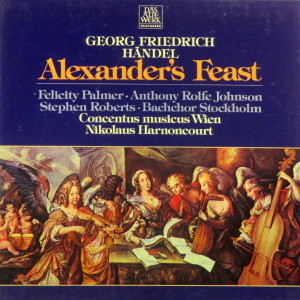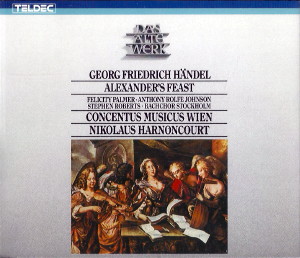 |
2 LP -
6.35440 EK - (p) 1978
|

|
| 2 CD -
8.35671 ZA - (c) 1984 |
|
Georg Friedrich
Händel (1685-1759)
|
|
|
|
|
|
|
|
Alexander's Feast or the
Power of Music
|
|
|
|
|
|
|
|
| Parte Prima |
|
56' 52"
|
|
| - Ouvertüre |
6' 30" |
|
A1 |
- Recitativo (Tenor) "'T was
at the royal feast"
|
1' 02" |
|
A2 |
| - Soli e Coro (Tenor, Sopran,
Chor) "Happy pair!" |
5' 26" |
|
A3 |
| - Recitativo (Tenor) "Timotheus,
plac'd on high" |
0' 26" |
|
A4 |
| - Accompagnato (Soprano) "The
song began from Jove" |
1' 02" |
|
A5 |
| - Coro "The list'ning crowd" |
2' 10" |
|
A6 |
| - Aria (Soprano) "With
ravish'd ears" |
3' 27" |
|
A7 |
| - Recitativo (Tenor) "The
praise of Bacchus" |
0' 33" |
|
B1 |
| - Aria e Coro (Baß, Chor) "Bacchus,
ever fair and young" |
4' 21" |
|
B2 |
| - Recitativo (Tenor) "Sooth'
with the sound" |
0' 43" |
|
B3 |
| - Accompagnato (Soprano) "He
chose a mournful Muse" |
1' 13" |
|
B4 |
| - Aria (Soprano) "He sung
Darius, gret and good" |
2' 59" |
|
B5 |
| - Accompagnato (Soprano) "With
downcast looks" |
0' 59" |
|
B6 |
| - Coro "Behold Darius great
and good" |
2' 41" |
|
B7 |
| - Recitativo (Tenor) "The
mighty master" |
0' 30" |
|
B8 |
| - Arioso (Soprano) "Softly
sweet in Lydian measures" |
2' 56" |
|
B9 |
| - Aria (Tenor) "War, he
sung, is toil and trouble" |
4' 53" |
|
B10 |
| - Coro "The many rend the
skies" |
3' 55" |
|
C1 |
| - Aria (Soprano) "The
Prince, unable to conceal his pain" |
6' 36" |
|
C2 |
| - Coro (da Capo) "The many
rend the skies" |
3' 55" |
|
C3 |
| Parte Seconda |
|
29' 03"
|
|
| - Accompagnato e Coro (Tenor,
Coro) "Now strike the golden Lyre
again!" |
2' 36" |
|
C4 |
| - Aria (Baß) "Revenge,
revenge, Timotheus cries" |
8' 00" |
|
C5 |
| - Accompagnato (Tenor) "Give
the vengeance due" |
1' 44" |
|
D1 |
| - Aria (Tenor) "The princes
applaud" |
2' 04" |
|
D2 |
| - Aria e Coro (Soprano, Coro) "Thaïs
led the way" |
5' 19" |
|
D3 |
| - Accompagnato e Coro (Tenor,
Coro) "Thus, long ago" |
5' 49" |
|
D4 |
| - Recitativo (Tenor, Baß) "Let
old Timotheus" |
0' 20" |
|
D5 |
| - Soli e Coro (Baß, Tenor,
Sopran, Coro) "Let old Timotheus
yield" |
3' 15" |
|
D6 |
|
|
|
|
Felicity Palmer,
Sopran
|
|
Anthony Rolfe
Johnson, Tenor
|
|
| Stephen Roberts,
Baß |
|
|
|
| Bachchor
Stockholm / Anders Öhrwall, Leitung |
|
|
|
CONCENTUS MUSICUS WIEN (mit
Originainstrumenten)
|
|
| -
Alice Harnoncourt, Violine |
-
Leopold Stastny, Blockflöte |
|
| -
Walter Pfeiffer, Violine |
-
Jürg Schaeftlein, Blockflöte, Oboe
|
|
| -
Peter Schoberwalter, Violine |
-
Paul Hailperin, Oboe |
|
| -
Wilhelm Mergl, Violine |
-
Milan Turkovic, Fagott |
|
| -
Anita Mitterer, Violine |
-
Otto Fleischmann, Fagott |
|
| -
Alison Bury, Violine |
-
Hermann Schober, Naturtrompete
|
|
| - Ingrid Seifert,
Violine |
-
Richard Rudolf, Naturtrompete |
|
| -
Richard Motz, Violine |
-
Othmar Berger, Naturhorn |
|
| -
Veronika Schmidt, Violine |
-
Hermann Rohrer, Naturhorn |
|
| - Christin Buchner,
Violine |
-
Kurt Hammer, Pauken |
|
| -
Kurt Theiner, Viola |
|
|
| -
Josef de Sordi, Viola |
|
|
| - Wouter Müller,
Violoncello |
|
|
- Nikolaus
Harnoncourt, Violoncello
|
|
|
| - Eduard Hruza,
Violone |
|
|
-
Herbert Tachezi, Orgel und
Cembalo
|
|
|
| -
Johann Sonnleitner, Cembalo |
|
|
| -
Toyohiko Satoh, Theorbe |
|
|
|
|
| Nikolaus Harnoncourt, Gesamtleitung |
|
|
Luogo e data
di registrazione
|
| Brema (Germania) - 7/8 ottobre
1977 - (Festival "Pro Musica Antiqua",
Radio Bremen) |
|
Registrazione
live / studio
|
| live |
Producer / Engineer
|
| - |
Prima Edizione
CD
|
Teldec "Das Alte Werk" -
8.35671 ZA - (2 cd) - 56' 52" + 39' 45"
- (c) 1984 - AAD
|
Prima
Edizione LP
|
Telefunken "Das Alte Werk" -
6.35440 EK - (2 lp) - 41' 51" + 43' 34"
- (p) 1978
|
|
|
Remarks on
performance practice
|
The scored strength of
the strings was chosen in accordance
with the acoustic conditions of the
performance location (the hall of the
Waldorf School in Bremen). In addition
there was a continuo
group such as one would more or less
expect in the Handel operas: two
harpsichords flanking the orchestra
right and left, an organ and a theorbo.
These instruments were used
collectively or individually
acccording to the dramatic situation
and the particular emotions required:
The ist overture
with all plucking instruments (2
harpsichords, theorbo),
with the theorbo alone
accompanying the violin solos and the
concluding minuet.
2nd recitative with organ, as from
"The Lovely Thais..." including the theorbo
in order tonally to underline the new
situation. 3. Aria e Coro with organ
and harpsichord. 4. Recitative only
with lute (Timotheus,
the singing poet who accompanies
himself "with flying fingers touch’d
the lyre”.) 5. Accompagnato with
organ. 6. Chorus: tutti with organ and
harpsichord, the high ranging string
passages with theorbo. Spatial tone is
striven for here: call and echo in the
vaults, frequent fading tones. 7.
Aria: all plucking instruments (2
harpsichords, theorbo),
the echo~type solos only with theorbo.
8. Recitative theorbo (as
4.), at ”sound the
trumpets” including harpsichord. 9.
Aria e Coro: first only with organ,
later theorbo and
left harpsichord joining in. 10.
Recitative with harpsichord on account
of the violent emotion. 11.
Accompagnato: here Handel writes
”senza Cembalo”, and thus the theorbo
was used. 12. Aria and 13. Accompagnato
with organ, in the chorus 14. a
harpsichord is also featured. 15.
Recitative: theorbo (as
4.). 16. Arioso: with
organ and theorbo, a popular
combination for soft, insinuating
emotions. 17. aria: on account of the
warlike emotions with two
harpsichords, as at chorus 18., here
also alternating with the dynamics of
the choir. 19, Aria: theorbo because
of the gentle mood. Accompagnato e
Coro: two harpsichords, occasionally
also alternating. 21.
Aria with organ, in the largo part
incoporating the theorbo.
22. Accompagnato and 23.
Aria: two harpsichords. 24. Aria e
Coro with organ and theorbo, with
chorus entry harpsichord instead of
theorbo. 25. Accompagnato e Coro:
theorbo with the
instruments, organ with the singer,
with the chorus only organ. 26.
Recitative: theorbo with
the tenor, organ with the bass,
continuing thus in the concluding
chorus, with soprano entry also the
harpsichord, then
organ, harpsichord and lute
collectively and alternatingly,
according to the dynamics and number
of the parts. Aria No. 27,
which in the premiere performance was
sung by a second soprano, was sung
here by the tenor because of the
emotion involved. Except for trumpets
and kettledrums, which played only at
the spots prescribed in the score, all
the instruments were applied in the
tutti and in such pieces whose
character appeared to require this.
This practice corresponds to the
custom of the time, not every
instrument performing in the unisono
was specified. For instance no oboes
are playing in the minuet at the end
of the overture, but certainly the
transverse flute with the strings, as
well as in the Aria and Chorus 24, and
so on.
Nikolaus
Harnoncourt
English
translations by Frederick A.
Bishop
|
|
Nikolaus
Harnoncourt (1929-2016)
|

|

|
|